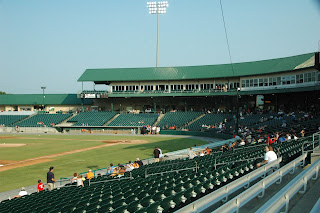With a pair
of friends, I take an annual vacation organized around minor league
baseball. With big breakfasts in the
mornings, brewpubs in the afternoons, and minor league ballparks in the
evenings, and with a few urbanist sightseeing stops thrown in, it’s a great
week. So great that this year, for our
seventh iteration, we’re extending ourselves to twelve days.
Baseball
Odyssey 2015 will begin and end in Birmingham, Alabama, with stops including
New Orleans, Memphis, and Nashville. To
get myself in the mindset for minor league ball in the South, I cracked open “Southern League” by Larry Colton.
Colton
writes about the 1964 season of the Birmingham Barons. In 1962, the Barons went on a hiatus because
a local ordinance prohibited integrated sports.
With professional baseball insisting
on full integration, a time-out was the only option. But by 1964, the Barons’ owner, emboldened by
the removal from office of strict segregationist Bull Connor and by the repeal
of the ban on integrated sports, was ready to resume play. However, the spectre of violence against
African-Americans, almost casual in its cruelty, remained high.
Colton tells
the story in a quiet, spare, and unadorned style. He doesn’t need to add his outrage to the
story. The facts that he has assembled
tell that story quite well on their own.
(Plus, any story that includes long-time Oakland A’s owner Charley
Finley in a key role can’t be boring.)
Although I
fully recommend the book, it doesn’t offer much of an urbanist connection. However, there is one small set of details that
impart an interesting urbanist insight.
To tell the story
of the 1964 Barons, Colton focuses on four particular ballplayers, Blue Moon
Odom, Tommie Reynolds, Hoss Bowlin, and Paul Lindblad. It’s interesting to note what each did with a
portion of their mostly small signing bonuses.
Odom, who
was the most highly regarded as a prospect and who went on to become the most
well-known of the four as a Major League ballplayer, spent $4,200 on a
“brand-new, candy-apple red Ford Galaxy”.
Odom was so fixed
on the car that Finley, the owner of the Kansas City A’s who were the parent
club to Birmingham, helped facilitate the purchase, making sure that it was
waiting for him, fresh from a Birmingham car dealer, when Odom arrived after
signing his contract. The delivery
method later caused trouble for Odom when he couldn’t explain to the
satisfaction of a white Birmingham police officer how a black man came to be
driving a flashy new car.
Reynolds,
who drove from his home in San Diego to spring training in Daytona Beach, used
a portion of his bonus on a “’64 Chevy Malibu Super Sport, with its wire rims,
aqua-green custom paint job, and front-seat console.” Reynolds and the car had a difficult
trip. As a black man unable to stay at a
motel in the Florida Panhandle, he tried to nap in a rest area, only to awake
to find one front window shattered and the other painted with a bullseye next
to his head.
Bowlin, who
had grown up dirt poor in rural Arkansas, went more modest with his first
acquisition, a “’56 Chevy with mud flaps and a brodie knob”.
Lindblad,
already married with two children, chose a “’63 Chevy Impala”, also a more
sedate selection, but still a new car and a big chunk of his bonus.
With those
four examples in mind, let’s consider the 2014 example of Dodger outfielder Joc
Pederson, starting leftfielder in last week’s All-Star Game, runner-up in the
Homerun Derby, and Rookie-of-the-Year candidate.
Pederson
completed his minor league apprenticeship with the 2014 Albuquerque
Isotopes. What wheels did Pederson, who
received a $600,000 signing bonus, use to get around in Albuquerque? A 1994 Buick Century that he bought for
$1,000.
As described by the Isotopes after Pederson donated
the car for a raffle, “The car, nicknamed “Little Chucky,” has only 166,000
miles on it and has at least one operable window, which is really all you need.
… Little Chucky will also come with two
complimentary air fresheners and whatever else Pederson forgets to clean out.”
Quite a
difference from the four Birmingham Barons of a half-century earlier and one
that says much about the changing attitude toward cars. And, as cars become less important, urbanism
becomes more important.
One could
argue that I cherry-picked these examples and they’d be half-right. I wouldn’t have reported the anecdotes if
they hadn’t supported my urbanist perspective.
But I didn’t go looking for these stories. They floated across my desk for other reasons
and I just happened to notice the information they imparted.
Also, I’m
not suggesting that all professional athletes are driving 20-year-old
beaters. A quick look at the players’
parking lot at any Major League ballpark would quash that suggestion. But Pederson does show that at least some
players can be pretty casual about their rides.
The world is
changing.
(Disclaimer:
Through a mutual acquaintance, I came to know Colton back in the late 1990s,
even playing a charity golf event or two.
We’ve long since lost touch, but I recall enjoying his company. However, I’d recommend “Southern League” and
his earlier books, particularly “Goat Brothers”, regardless of past golf
outings. He writes well on subjects
about which I care.)
Next time, I
have some good news from Napa. It’s
progress that I’ve long been advocating.
As always,
your questions or comments will be appreciated.
Please comment below or email me.
And thanks for reading. - Dave Alden (davealden53@comcast.net)

No comments:
Post a Comment